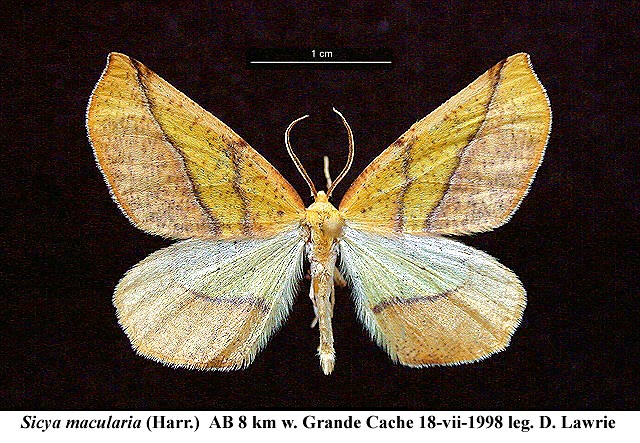Species Details
Sicya macularia
University of Alberta E.H. Strickland Entomological Museum Read more about this collection »
Common NamePink-bordered Yellow, Two-pronged Looper
SeasonalityAdults fly from mid July to early September,peaking from late July to early August.
IdentificationOne of the most widespread and recognizable geometrid moths. The broad pinkish borders on a yellow ground colour make this mid-sized geometrid distinctive, although the intensity of the pink margins varies considerably. Females are slightly larger with coarser dark speckling in the wing margin
Scientific Name
Sicya macularia
Common Name
Pink-bordered Yellow, Two-pronged Looper
Habitat
Widespread in deciduous or mixedwood forests, woodlands and shrubby areas.
Seasonality
Adults fly from mid July to early September,peaking from late July to early August.
Identification
One of the most widespread and recognizable geometrid moths. The broad pinkish borders on a yellow ground colour make this mid-sized geometrid distinctive, although the intensity of the pink margins varies…
One of the most widespread and recognizable geometrid moths. The broad pinkish borders on a yellow ground colour make this mid-sized geometrid distinctive, although the intensity of the pink margins varies considerably. Females are slightly larger with coarser dark speckling in the wing margin
Life History
The unique larva of this species, as the name suggests, has two tongue-like lobes along its back, unlike any other looper. In addition, the colouration and texture is bark-like, making it an excellent twig mimic (see…
The unique larva of this species, as the name suggests, has two tongue-like lobes along its back, unlike any other looper. In addition, the colouration and texture is bark-like, making it an excellent twig mimic (see Ives & Wong 1988 and Wagner et al. 2003). Pupation is in a loose cocoon among foliage. The pupa is very glossy, reflecting the colours of its surroundings. The nocturnal adults, emerging in late summer, resemble yellowing or wilted leaves. Eggs are laid on twigs and in old alder catkins, and overwinter (McGuffin 1987).
Conservation
Not of concern.
Diet Info
Larvae feed on deciduous shrubs and trees, such as alder, shrubby cinquefoil, currants, false azalea, blueberry, spiraea, willow and poplar (McGuffin 1987).
Range
Transcontinental in Canada, from coastal BC to Newfoundland, from southern YT and NT south to GA, MS and CA (McGuffin 1987, Wagner et al. 1997).
References
Author
Wagner, David L.; Giles, Valerie; Reardon, Richard C. and Michael L. McManus
Title
Caterpillars of eastern forests.
Publication Date
1997
Pages
113
Author
McGuffin, W. C.
Title
Guide to the Geometridae of Canada (Lepidoptera): II. Subfamily Ennominae, 4
Publication Date
1987
Series Title
Memoirs of the Entomological Society of Canada
Volume
138
Pages
182
Author
Ives, W. G. H. and H. R. Wong
Title
Tree and shrub insects of the prairie provinces
Publication Date
1988
Pages
327
Specimen Information
There are 112 specimens of this Species.
UASM7116 - Sicya macularia
University of Alberta E.H. Strickland Entomological Museum
Place CollectedCanada: Alberta, Tofield
Collected BySchmidt, B. C.
Date Collected1999-08-04
UASM10234 - Sicya macularia
University of Alberta E.H. Strickland Entomological Museum
Place CollectedCanada: Alberta, Nordegg
Collected ByBowman, K.
Date Collected1917-08-28
UASM10235 - Sicya macularia
University of Alberta E.H. Strickland Entomological Museum
Place CollectedCanada: Alberta, Cadomin
Collected ByBowman, K.
Date Collected1920-08-25
UASM10236 - Sicya macularia
University of Alberta E.H. Strickland Entomological Museum
Place CollectedCanada: Alberta, Cadomin
Collected ByBowman, K.
Date Collected1920-08-25
UASM10237 - Sicya macularia
University of Alberta E.H. Strickland Entomological Museum
Place CollectedCanada: Alberta, Banff National Park, Banff
Collected ByBowman, K.
Date Collected1926-08-06
UASM10238 - Sicya macularia
University of Alberta E.H. Strickland Entomological Museum
Place CollectedCanada: Alberta, Nordegg
Collected ByBowman, K.
Date Collected1917-08-23
UASM10240 - Sicya macularia
University of Alberta E.H. Strickland Entomological Museum
Place CollectedCanada: Alberta, Nordegg
Collected ByBowman, K.
Date Collected1940-08-01
UASM10241 - Sicya macularia
University of Alberta E.H. Strickland Entomological Museum
Place CollectedCanada: Alberta, Jasper National Park, Jasper
Collected ByBowman, K.
Date Collected1946-08-22
UASM10242 - Sicya macularia
University of Alberta E.H. Strickland Entomological Museum
Place CollectedCanada: Alberta, Nordegg
Collected ByBowman, K.
Date Collected1917-08-24
UASM10244 - Sicya macularia
University of Alberta E.H. Strickland Entomological Museum
Place CollectedCanada: Alberta, Nordegg
Collected ByBowman, K.
Date Collected1924-09-08
UASM10246 - Sicya macularia
University of Alberta E.H. Strickland Entomological Museum
Place CollectedCanada: Alberta, Nordegg
Collected ByBowman, K.
Date Collected1917-08-24
UASM10251 - Sicya macularia
University of Alberta E.H. Strickland Entomological Museum
Place CollectedCanada: Alberta, Nordegg
Collected ByBowman, K.
Date Collected1917-08-28
UASM10252 - Sicya macularia
University of Alberta E.H. Strickland Entomological Museum
Place CollectedCanada: Alberta, Edmonton
Collected ByBowman, K.
Date Collected1942-08-04
UASM10253 - Sicya macularia
University of Alberta E.H. Strickland Entomological Museum
Place CollectedCanada: Alberta, Edmonton
Collected ByBowman, K.
Date Collected1953-08-15
UASM10254 - Sicya macularia
University of Alberta E.H. Strickland Entomological Museum
Place CollectedCanada: Alberta, Edmonton
Collected ByBowman, K.
Date Collected1917-07-23
UASM10255 - Sicya macularia
University of Alberta E.H. Strickland Entomological Museum
Place CollectedCanada: Alberta, Edmonton
Collected ByMackie, Donald
Date Collected1917-07-25
UASM10256 - Sicya macularia
University of Alberta E.H. Strickland Entomological Museum
Place CollectedCanada: Alberta, Edmonton
Date Collected1915-07-23
UASM10257 - Sicya macularia
University of Alberta E.H. Strickland Entomological Museum
Place CollectedCanada: Alberta, Nordegg
Collected ByBowman, K.
Date Collected1924-09-08
UASM10258 - Sicya macularia
University of Alberta E.H. Strickland Entomological Museum
Place CollectedCanada: Alberta, Banff National Park, Banff
Collected ByBowman, K.
Date Collected1920-09-05
UASM10259 - Sicya macularia
University of Alberta E.H. Strickland Entomological Museum
Place CollectedCanada: Alberta, Edmonton
Collected ByBowman, K.
Date Collected1942-07-19
UASM10260 - Sicya macularia
University of Alberta E.H. Strickland Entomological Museum
Place CollectedCanada: Alberta, Midnapore
Date Collected1915-08-06
